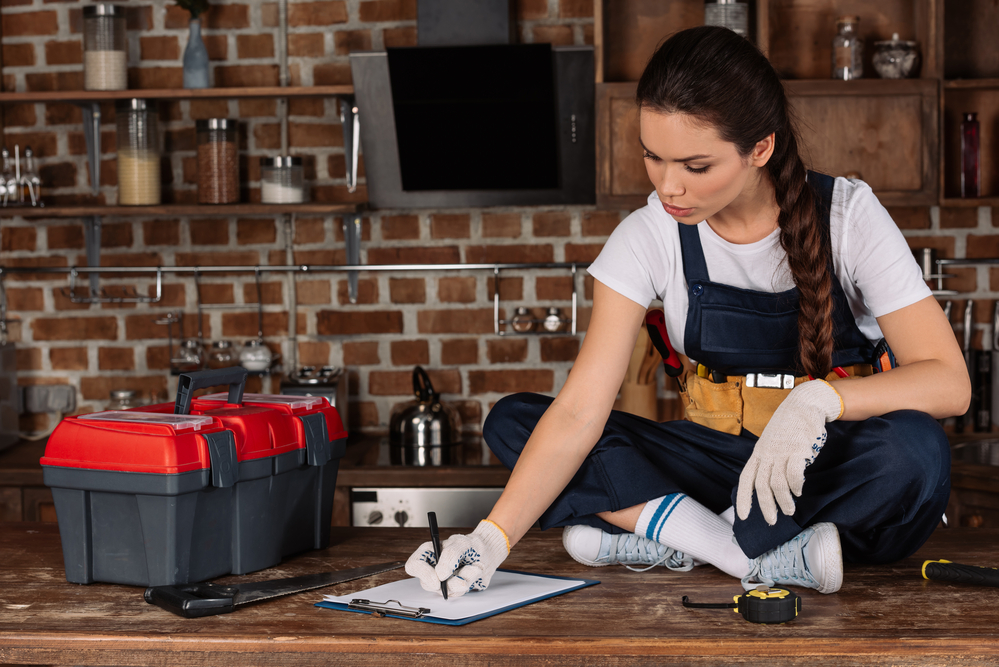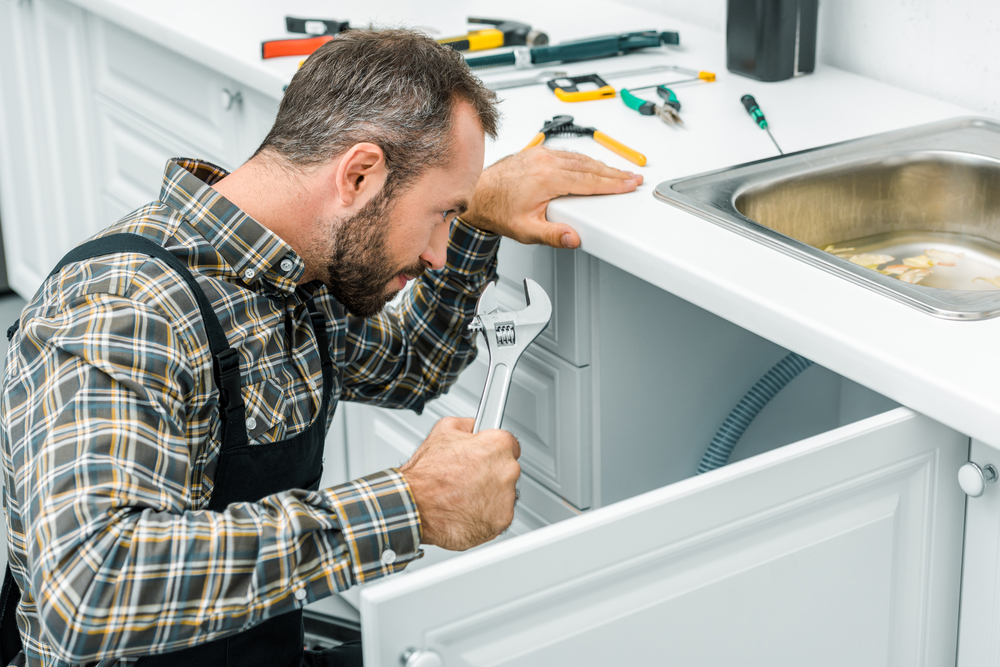

We may earn revenue from the products available on this page and participate in affiliate programs. Learn More ›
Q: I’m so excited to be buying my first home, but I’ve watched friends run up huge credit card bills paying for expensive repairs—it seems like when you own a home, everything breaks down at once! How can I budget so that this kind of maintenance doesn’t eat up all my credit?
A: You’re wise to be thinking about a home maintenance budget, because you’re right: One of the toughest parts of homeownership is that when it rains, it pours, and being unprepared can result in huge repair and replacement costs. It makes much more sense to tuck away a little money on a regular basis so that you’re ready when the time comes, and don’t have to make tough decisions or skimp on repairs because you can’t afford them. Also, it’s good to keep in mind that sometimes maintenance can result in “project creep,” where a repair becomes a replacement, and a replacement becomes a remodel or renovation. Having money set aside can open up options for renovation if the opportunity presents itself. Saving money for anticipated costs can be hard, especially when you’ve just bought a new home, but even if you can’t save as much as you’d like right from the beginning, it’s important to start saving something for home maintenance as soon as you move in.
The widely accepted rule of thumb is to set aside 1 to 4 percent of your home’s value every year for home maintenance, which includes both repair and replacement costs.
How much should you save each year for maintenance on your home? Well, how much did you pay for your new house? If it’s a recent purchase, you can use that number as the presumed value of your house—after all, you were willing to pay that much, and you weren’t outbid. If your home is older, you can look at market values on local real estate websites, or look at your local tax assessor’s valuation and use that as a starting point. The general estimate of how much to budget for home maintenance is between 1 and 4 percent of this value per year. This is because the average annual maintenance cost of a home works out to be just over 1 percent of its value. Budgeting a little more than the average cost will allow you to prepare for bigger-ticket repairs and replacements that can crop up and throw off the 1 percent figure, such as roof replacement, HVAC system failures, or other high-cost repairs.
However, a home’s age (as well as other factors) can affect how much you should save for repairs.
Quite simply, new houses have lower average maintenance costs than older ones do. Large systems are less likely to fail, wiring is less likely to have been poorly rerouted by previous homeowners, and everything inside the walls is more likely to still be dry. Older homes have histories and the baggage of other people’s repairs, so they’re generally more likely to need repairs, and the repairs are going to be complex and more expensive. If your house is less than 10 years old, saving 1 percent of the value per year is probably sufficient. But for a home that is more than 30 years old, it’s wise to lean toward the 4 percent figure in anticipation of large repairs or replacements. Weather and climate can also be factors that add to how much to budget for home maintenance; homes in areas with heavy rainfall or in a generally damp climate can suffer more wear and tear over time, so saving more than 1 percent is generally advisable.

Another way to calculate how much to budget for home maintenance is to put away $1 per square foot of your home.
Sometimes home values can be tricky to pin down, especially if the real estate market is volatile. In that case, you can consider basing your yearly house maintenance budget on the square footage of your home, tucking away $1 per square foot of your home. This is a good baseline, but in the end it’s less reliable than using the home’s value as an estimator—the cost to replace a roof in one area may be wildly different from the cost to do the same job in another area, even if both homes are the same size. If you can’t establish the value or are looking for a simpler method of calculation, the dollar per square foot system will give you a good starting point, but for more accurate budgeting do some research on your home value.
Once a baseline amount to set aside for repairs is established, it’s a good idea to consider the age and condition of systems in your home.
The age of the home is one thing, but how old are its parts? Basic home maintenance budgets are designed to cover the yearly maintenance cost—the things you do regularly, like mowing the lawn and maintaining the mower, fixing small leaks, sealing grout or countertops, and cleaning your home’s exterior. You can create a home repair costs list to start tracking the amounts you’re spending on these basic tasks, which will help you more accurately budget for the following years.
But if the systems and appliances in your home are older, you’ll want to make sure you’re financially prepared to take the hit that an expensive system replacement can be. Check on the ages of your furnace or boiler, air conditioners, plumbing and electrical systems, and hot water heater: If they’re nearing the end of their expected lifespans, you can expect more repairs and start to plan for their eventual replacement, which will add to your already-budgeted basic maintenance savings. Kitchen and laundry appliances should also be gauged: how often are they used? How long are you expecting them to last? Roughly planning to replace these appliances before they all force you to do so allows you to shop for good bargains and choose the items you want, rather than having to take what’s available in an emergency. Having money set aside in your home repair budget will make it easier to plan for system repair or replacement.
Consider increasing the amount you save to cover the cost of emergencies.
Even if you’ve carefully planned ahead, emergencies still happen. The water heater blows 3 years before you expected it to. You wake up one winter morning and the thermostat is 10 degrees below where you set it. Or the oven decides it’s given its all the day before a major holiday meal. These panic-inducing situations can lead to homeowners spending more than they would have otherwise and slapping that cost onto a credit card or pulling money from a line of credit. If your home is older, it’s best to plan ahead for emergency repairs by doing some research on the type and cost of the replacements you’d choose for each of your systems and appliances. Once you have those estimates, add a bit to the anticipated cost for the labor of the technicians that may be needed to install the replacements. This number may be shocking, but remember that it’s unlikely that all the appliances and systems will fail at the same time (although they do seem to have a knack for failing in groups). As a result, you don’t need to have all this money saved, but you’ll want to increase the amount you’re setting aside to be better prepared for a sudden failure at an inconvenient time.

Good and regular maintenance can help save on the cost of repairs and replacements.
Why is a maintenance budget important? Even without a major system or appliance failure, average home maintenance costs can mount quickly. The irony is that one of the best ways to reduce overall house maintenance costs is to spend money on basic house maintenance. If you’ve budgeted money for an annual inspection of the HVAC system, a technician can catch a minor problem before it becomes a major one. Spending the money to clean your siding and roof will prevent mold and mildew buildup, which can shorten the lifespan of those components. Paying to top up the insulation in the attic can make your home more energy efficient and put less strain on the heating and air conditioning. Hiring someone to replace the caulk around your shower can stave off mold infestation in the walls. Maintenance itself will keep your appliances and systems in good working order, maximize their lifespan, and help you find problems while they’re small and less expensive to repair. In addition, having technicians who are familiar with your home can be a great source of information: Technicians know the machines they work on, and they can likely forecast how much useful lifespan your systems have remaining so you can more accurately plan for replacement.
A home warranty policy may be worth exploring and can help save on the cost of maintenance, repairs, and replacement on major systems and appliances in your home.
Especially for cash-strapped new homeowners and owners of older homes, a home warranty can be a great option. Home warranties function similarly to homeowners insurance policies—you’ll pay an annual premium, commit to a set service call charge (similar to, but usually much lower than, a deductible), and purchase a policy. While homeowners insurance protects you financially against damage caused by weather, accidents, fires, and theft or damage, a home warranty policy protects your major home systems and appliances (depending on your policy) from deterioration or failure that results from age or regular wear and tear.

A home warranty from one of the best home warranty companies can potentially save you a lot of money in several ways. First, you won’t hesitate to call for service because you’re worried about how much the service call will cost: Everyone has heard horror stories of calling for repairs and having the job end up costing $1,000 instead of the $100 the homeowner was anticipating. With a home warranty, the cost of the service calls is set in the contract and usually range between $55 and $150. That fee covers the cost of the visit, any parts that are needed for repair, labor, and, if necessary, the replacement of the appliance or system. This gives you the security of knowing how much the call will cost regardless of how big the problem is, which may make you more likely to call for service on small problems before they become too big to ignore.
If your system or appliance needs replacement, the home warranty will cover that up to the coverage maximums stated in your policy for the cost of the initial service charge. There is, of course, fine print: You’ll want to study your policy closely to make sure you know what appliances and systems are included and which are not, and to understand the kind of wear and tear that is covered. You’ll also want to make sure you save records of any maintenance or service you and the previous homeowner have done so you can demonstrate that the systems were well maintained and cared for. But if you’ve read the policy and understand what it covers, it can easily pay for itself with two or three service calls that result in repairs. It’s a solid option for new homeowners to help budget for unexpected surprises while they build up their emergency and maintenance savings, and for any homeowner with older systems who wants to plan and budget ahead for good, regular maintenance.
